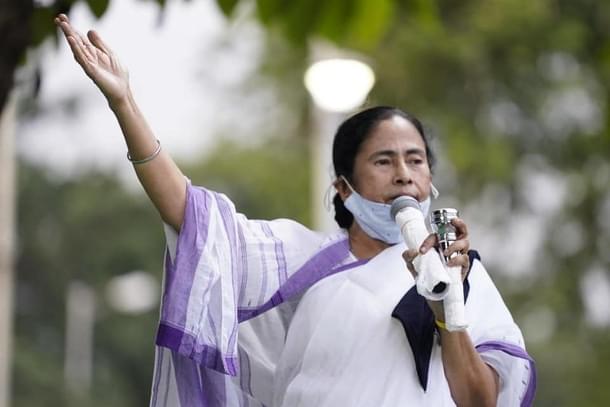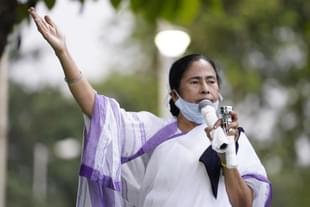Economy
In Numbers: Even As Mamata Banerjee Extends Support To ‘Farmer Protests’, Agriculture In Bengal Struggles
Jaideep Mazumdar
Dec 28, 2020, 01:34 PM | Updated 01:34 PM IST
Save & read from anywhere!
Bookmark stories for easy access on any device or the Swarajya app.


Bengal Chief Minister Mamata Banerjee has waded into the ongoing stir by a section of farmers from some north Indian states and expressed solidarity with them. However, the stir against the three farm laws has not found any resonance in Bengal.
That’s because the new laws do not affect Bengal at all. Farmers in the state are pretty much free to sell their produce to private buyers anyway, including large corporates.
Contract farming exists in Bengal, and little of the wheat and paddy produced in the state is procured by the government.
Hence, farmers of Bengal have no quarrel with the new laws. What bothers them is the apathy displayed towards them by the new ‘champion of farmers’ — Mamata Banerjee.
Since coming to power in 2011, Banerjee has done little for farmers in the state except announcing meagre doles which, anyway, allegedly get siphoned off by her party functionaries in the villages.
What ails agriculture in Bengal is its very nature. Fragmented and small land holdings had made farming unremunerative in Bengal.
Since land holdings are so small, farmers cannot afford mechanisation and a lot of inputs which would have increased their yields and reduced costs.
Also, lack of a functional cold chain for most crops means farmers do not get remunerative prices for their produce and have to watch their crops rotting.
The poor industrial climate in the state that is infamous for extortionist ‘syndicates’, coupled with the perceived industry-unfriendly image of Banerjee (perpetuated after her chasing away the Tata Motors plant from Singur), has resulted in large corporates shying away from investing in agriculture.
All these have resulted in farmers of Bengal surviving at a subsistence level and agriculture becoming largely unviable.
The average holding (agricultural plot) size of a farm in Bengal is 0.77 hectares (2010-2011 figures from state agriculture department: see this and this). Since then, the holdings would have fragmented further.
Bengal may rank at number one in the country in production of rice, jute and vegetables, and second in producing potatoes, but most of all that (barring jute) is subsistence farming. That is, the farmers consume most of what they produce.
As a result, agriculture is unremunerative and the lakhs of small and marginal farmers have to work as daily wage earners or in other vocations as unskilled and semi-skilled labourers to earn an actual livelihood.
The state’s total cultivable area is 56 lakh hectares, which is 63 per cent of its total geographical area of 88.75 lakh hectares.
The number of operational agricultural holdings in the state (2010-2011 figures) is 71.23 lakhs, of which 60.32 lakhs are small and marginal holdings.
According to sate government statistics, of the 71.23 lakh farmers in the state, an overwhelming majority of 96 per cent are small and marginal farmers.
To add to the woes of the farmers, just about 60 per cent of the net cropped area is irrigated. While that’s the claim of the state agriculture department, independent experts say that the figure is grossly exaggerated and just about one-third of the total arable land in Bengal is irrigated.
Thus, a large number of farmers, mostly small and marginal ones, are adversely affected every year by the vagaries of nature.
Given the fact that most agricultural holdings (or farm plots) in Bengal fall in the small and marginal category, it would have been logical for the state government to encourage investments in agriculture and contract as well as collective farming.
Corporate houses ought to have been encouraged to invest in agriculture by creating an effective cold chain involving cold storages and refrigerated carriers for transporting agricultural produce. The state government ought to have acted as a facilitator in export of farm produce to other parts of the country and abroad.
To enhance farm incomes and make agriculture viable, the Bengal government could have facilitated large-scale organic farming like neighbouring Sikkim.
Perhaps the greatest disservice that Banerjee did to Bengal’s farmers was her trenchant opposition to Tata Motors at Singur that created her capital-unfriendly image.
No matter how hard she tried over the last nine years since taking over the reins of power in Bengal, that image and perception has stuck on.
This is the state agriculture department’s own admission: “Deterioration of soil health due to imbalance in use of chemical fertilizers, paucity of suitable improved varieties of seeds, inadequate farm mechanization, unorganized marketing structure etc are major challenges to agricultural growth” .
While the ailments have been correctly diagnosed, next to nothing has been done over the past nine years to treat them effectively.
Not only has farming become unviable in Bengal, this sector is staring at a grave crisis now. That’s because of the following factors:
One, with agricultural plots shrinking in size as they get passed on from one generation to the next, more and more farmers will need to be engaged in alternate or allied vocations.
But with nothing available due to lack of investments in the state, farmers will have to start migrating out of the state to look for work.
This will result in more and more agricultural plots lying fallow since it would become unremunerative to grow crops on them and there will be no able farm hands to cultivate them.
Two, overuse of chemical fertilisers and pesticides will result in sharp deterioration of soil health. One of the ways out would have been to encourage farmers to turn to organic farming.
But in the absence of any such initiative from the state, and with soil health declining, crop yield will fall drastically.
Also, with more and more consumers becoming environmentally conscious, the toxic produce, especially vegetables, from Bengal will find few takers.
Three, lack of irrigation will also result in overuse of groundwater and the resulting depletion of the groundwater table.
This will lead to fluoride and arsenic contamination of groundwater, thus affecting health of crops as well as farmers and their families.
Large areas in Bengal, especially the districts where agriculture is a prime vocation, are suffering from groundwater contamination and this will only worsen.
Four, due to declining size of farm holdings and agriculture becoming increasingly subsistence in Bengal, farmers will find it more and more difficult to access institutional loans.
Farmers will, thus, have to depend on money-lenders for loans to buy seeds, fertilisers and other agricultural inputs, or to fund their family expenses.
This will lead them deeper into debt traps.
“Not only has Mamata Banerjee done nothing for the farm sector in Bengal over the last nine years, her apathy towards farmers is apparent from her refusal to bring Bengal under the Pradhan Mantri Kisan Samman Nidhi through which farmers would have got money from the Centre,” said state BJP chief Dilip Ghosh.
Prime Minister Narendra Modi himself red-flagged this recently while releasing Rs 18,000 crore under the scheme under which money is transferred directly to bank accounts of farmers.
States are required to provide the Union government with complete details of farmers and their bank accounts.
Bengal has been refusing to provide these details and has, instead, been insisting that the money meant for farmers be transferred to its account and it would then disburse the money to the farmers of the state.
Since the PM Kisan Samman Nidhi is a direct cash transfer scheme, the Centre has repeatedly turned down the state’s request.
The reason Banerjee is insisting that the money meant for Bengal’s farmers be transferred to the state’s account is that she wants to take credit for it.
“We have seen the corruption by Trinamool functionaries in disbursing relief to those affected by cyclone Amphan, and during the lockdown. Foodgrains and other relief provided by the Centre for the affected were siphoned off by Trinamool functionaries. This (Mamata Banerjee) government cannot be trusted,” said Dilip Ghosh.
Banerjee’s propensity to play politics has, thus, adversely affected Bengal’s farmers. Thanks to lack of concrete initiatives in the farm sector, agriculture in Bengal is staring at a grave crisis.
Banerjee would do well to bring relief to Bengal’s farmers instead of her narrow politics-driven expressions of solidarity with the agitating farmers of Punjab.
Jaideep Mazumdar is an associate editor at Swarajya.





